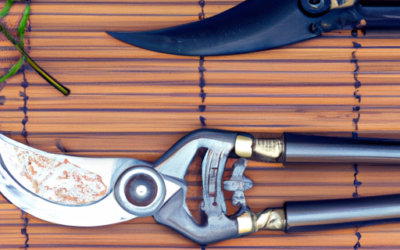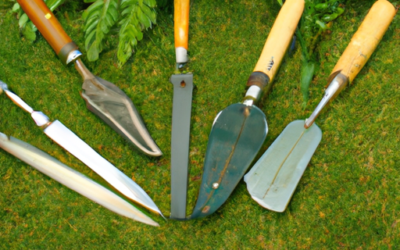Looking after a Japanese garden requires particular attention and detailed care. Most importantly, however, having the right tools in your arsenal can significantly ease the difficulty of maintaining such a beautifully complex landscape. “Choosing The Right Pruners For Your Japanese Garden: A Buyer’s Guide” provides you with exclusive insight into making the correct decision about pruners – a garden essential – to preserve your Japanese garden’s regality and grandeur. It’s all about helping you seek out the perfect pruner for your garden’s specific needs, focusing on tool quality, functional design and inherent durability. Brace yourself for a journey into the world of garden pruners and prepare to enhance your gardening experience.
Understanding the Importance of Pruning in Japanese Gardening
Japanese gardens are renowned for their pristine beauty and tranquility, often reflecting a peaceful harmony with nature. However, maintaining this serene environment requires a lot of care and attention, one of which is pruning.
Role of pruning in maintaining a Japanese garden
Pruning plays a pivotal role in maintaining the aesthetic appeal of a Japanese garden. It’s not just about cutting back growth, it is a careful endeavor to shape the plants and trees to match the overall design aesthetic of the garden. In other words, pruning offers you control over the visual narrative of your garden by managing plant size, enhancing plant health, and directing plant growth.
Contribution of pruning to aesthetic appeal
Japanese gardens are not just about the greenery, but also about achieving a balance between all the elements. Proper pruning allows you to achieve this balance, be it through creating cloud-like forms in trees, revealing carefully crafted views, or even creating a sense of age and maturity in your plants. Pruning to aesthetic appeal is an art form in itself, requiring a careful and considerate approach.
Effects of improper pruning on plant health
Improper pruning can have detrimental effects on plant health. Incorrect cuts can leave plants vulnerable to disease and pest infestation. Not only that, but reckless pruning can disrupt a plant’s natural growth cycle, leading to weak or uneven growth. It’s crucial to follow the proper techniques and use the right tools when pruning your plants.
Different Types of Pruners
The tools you use for pruning can significantly influence the outcome. Selecting the right kind of pruners can make the difference between a professional-looking finish and a hacked appearance.
Anvil pruners
Anvil pruners have a single straight cutting blade that closes onto a flat surface, the ‘anvil’. These pruners are excellent for cutting dry and deadwood, as they crush through the material. However, they’re not ideal for green, living stems, as they can cause crushing damage.
Bypass pruners
Bypass pruners work much like scissors, with two blades ‘bypassing’ each other to make a cut. These are great for cutting live, green plants, as they provide a clean, close cut, promoting faster healing.
Ratchet pruners
Ratchet pruners contain a mechanism that cuts in stages, making it less strenuous on the hand when cutting through larger branches. Ideal for individuals who don’t have a lot of hand strength but need to handle thick branches.
Compound action pruners
These pruners are designed with a compound lever system to give you more cutting pressure with less effort. If you have a lot of heavy-duty pruning, these can be a good option.
Identifying Your Pruning Needs
Knowing exactly what you need from your pruners can help you make a more informed choice. This often depends directly on the types of plants in your Japanese garden and how you want them to look.
Types of plants in your garden
The type of plants you have in your garden will dictate the kind of pruner you need. For instance, if you have a lot of thick, tough branches, a set of anvil pruners may be best for you. Smaller, more delicate plants may require bypass pruners instead.
Desired shape and look of plants
This factor is especially important in a Japanese garden, where pruning is often done for aesthetic reasons. If you’re going for the cloud-pruned look, for example, you might need a nimble set of pruners that will allow you to shape your plants intricately.
Frequency of pruning tasks
This can greatly affect the type of pruner you’ll need. If you only prune occasionally, an inexpensive option may do the trick. However, frequent pruning users should invest in a higher-quality set of pruners, as you’ll want them to last and stay sharp for longer.
Factors to Consider When Buying Pruners
When you’re shopping for the right pair of pruners, there are several important factors to consider.
Ergonomics
If you’re doing a lot of pruning, you’ll want to make sure your pruners are comfortable to hold and easy to use. Look for pruners with soft, non-slip grips and consider ones with a rotating handle, which can reduce hand fatigue.
Durability
Investing in a sturdy pair of pruners can save you money in the long run. Look for ones that are made of high-quality materials and have replaceable parts.
Blade quality
Consider the quality of the blade. Carbon steel blades tend to be sharper and stay sharp for longer, but stainless steel blades resist rust. Moreover, blades with a non-stick coating can make your work much easier.
Ease of maintenance
Pruning tools should be easy to clean and maintain. Some pruners come apart for easy cleaning, and others provide easy access to the blade for sharpening.
Top Pruning Brands for Japanese Gardens
Choosing the best pruning brand for a Japanese garden can be a little overwhelming, but here are some to consider that are known for their quality and durability.
Felco
Felco is a well-established brand known for its premium-quality pruning shears. Their pruners are ergonomic, durable, and universally recognised as some of the best in the market.
Fiskars
Fiskars is another trusted brand when it comes to pruning tools. They offer a wide variety of options, from traditional pruners to modern, innovative designs.
ARS
ARS is a Japanese brand, well-known for their sharp and durable blades. Their pruners cut smoothly, so you can achieve that perfect aesthetic you’re aiming for in your garden.
Gardena
Gardena is an excellent choice for their ergonomic design and blade quality. They’re easy to use, and their blades can be easily cleaned and replaced.
Specific Pruners for Specific Tasks
Not all pruners are suitable for all tasks. Depending on the size and nature of your pruning job, you may need different types of pruners.
Shears for high branches
For those high branches out of reach, long-handled pruning shears, also known as loppers, would be ideal. They allow you to prune higher branches without requiring a ladder.
Secateurs for thicker branches
Secateurs are excellent for cutting thicker branches. They’re the classic pruning tool and come in anvil, bypass, and ratchet types to suit your particular needs.
Snips for precision pruning
For precision pruning, pruning snips are your best friend. They’re perfect for getting in those small spaces and making exact cuts to keep your plants looking just right.
Safety Considerations for Pruning
Pruning might seem harmless, but it can be dangerous if not done safely. Always remember to consider safety first.
Proper handling of pruners
Proper handling of pruners is essential to avoid any accidents. Always use the locking mechanism on your pruners when they’re not in use, and avoid using pruners that are damaged or malfunctioning.
Importance of safety goggles
Safety goggles are essential to protect your eyes from falling debris or accidental sprays of sap. Also, be aware of where your other hand is while you’re making cuts.
Proper disposal of cut branches
Cut branches should be disposed of properly to avoid any accidents. Consider a compost pile or disposing of cut branches in a garden waste bin.
Maintenance of Pruners
Regular maintenance can extend the life of your pruners and keep them working smoothly and efficiently.
Regular cleaning
It’s essential to clean your pruners regularly to remove sap and other residues. Regular cleaning can also prevent rusting and keep the blades sharp for longer.
Sharpening of blades
Over time, blades become dull, which makes pruning harder and can hurt your plants. Therefore, it’s essential to sharpen your blades regularly to ensure clean cuts.
Proper storage
Proper storage is essential to keep your pruners in the best possible condition. Keep them in a dry place and oil the joints regularly to prevent rust.
Utilising Pruners for Different Seasons
Pruning needs can change according to the season and the type of plants you have.
Winter pruning needs
Pruning in winter requires you to remove dead or diseased wood that might harm your plants. Winter is also the best time to prune many trees and plants as they’re in their dormant phase.
Summer pruning needs
Summer pruning is all about directing the growth of your plants. During this season, you’ll mainly be doing light pruning of your plants to keep them in shape.
Any seasonal changes in pruning method
Each season brings different pruning needs. In spring, you may be shaping your flowering plants while preparing your trees for the coming seasons. In autumn, you’re likely to be readying your garden for the colder months and removing any dead or dying summer growth.
Alternatives to Pruners
While pruners are typically the go-to tool for most pruning jobs, there are alternatives that could be more suitable for certain tasks.
Hand saws
Sometimes, branches are just too thick for pruners. In these cases, a good hand saw is invaluable. It’s also handy for chopping up larger branches for easier disposal.
Loppers
Loppers are essentially pruners with long handles. They’re great for reaching into shrubs, over small trees, or for any branches up to about 2 inches thick.
Pole pruners
Pole pruners are your best friend for those jobs that require a little extra reach. This tool can help you prune branches that are several feet above the ground without needing a ladder.
When to use alternatives versus pruners
Each tool has its advantages and disadvantages, and knowing when to use which tool can make your pruning jobs go a lot smoother. Generally, pruners are the right tool for most small to medium-sized branches and for precise shaping work. In contrast, saws, loppers, and pole pruners are best for larger branches or when you need a bit of extra reach.
In conclusion, choosing the right pruning tool for your Japanese garden requires understanding the nature of your plants, the delicate balance of aesthetics in your garden, and the tasks you frequently carry out. Furthermore, regular maintenance, seasonal considerations, and safety should always be a priority. Happy pruning!








